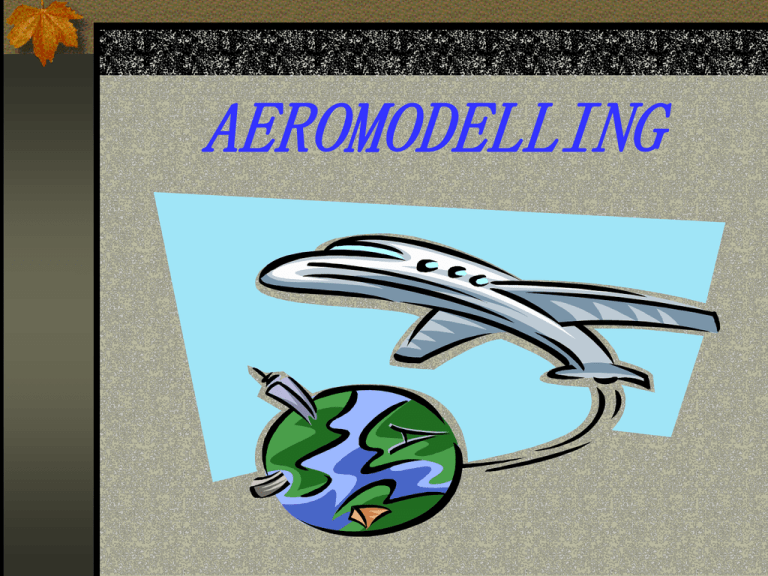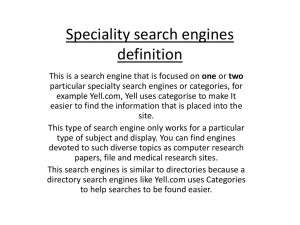Aeromodelling in the NCC
advertisement

AEROMODELLING INTRODUCTION • Aero modelling is the one of the finest hobbies, which is very popular world wide among people of all ages and professions. It has often been the starting point of many Pilots and Aeronautical engineers. “It is a hobby in which a cadet learns to build up the model of actual aircrafts which are unable to carry persons and used for sports purposes”. INTRODUCTION • WHY AEROMODELLING STARTED IN NCC The aim of introducing Aeromodelling in the NCC curriculum is to increase the air-mind ness in the youth of our country. If taken in right lines, it can be extremely thrilling for all. By constructing the models by one’s own hands, one can understand the various principle of flight and problems of construction. INTRODUCTION • WHEN AEROMODELLING STARTED • The history of Aeromodelling goes back much further than the history of real aircraft. • It is started in the nineteenth century by Dr. Thomas Young by discover the lifting property of a cambered surfaces comparison to flat surface. INTRODUCTION Sir George Caley built a helicopter model in 1796. John Stringfellow built a spring operated model in 1842. Alphonse Penand invented model fitted with tail surfaces and wings with dihedral angle. In 1918, Professor Langley built a petrol driven model called Aerodrome No. 5. This revolutionised the concept of Aeromodelling as there was now an ideal power plant small enough are used in aero models. MATERIAL USED IN AEROMODELLING • Aeromodelling requires a variety of materials. Selection of correct material and proper use of the same are important factors of this hobby. 1. WOOD (a) Balsa: * This wood is very light and can easily work for almost every purpose in Aeromodelling. * It can be drawn in sheets of even 1mm thickness. * First found in the forest of South America. MATERIAL USED IN AEROMODELLING (b) Spruce: * This wood is light as well as strong. * It is used in full sized a/c and heavier type of models. * Mainly used for fuselage, wings and spars etc. (c) Birch: * It is stronger than the wood spruce but also heavier. * It is used where extreme strength is required. MATERIAL USED IN AEROMODELLING (d) Bass wood: * It is much stronger than Balsa. * Bass wood is idle for making propellers and wings of Solid models. (e) Plywood: * Plywood sheets are used for panelling work, formers, wing tips and doublers MATERIAL USED IN AEROMODELLING (f) Cane and Bamboo: These are used for tail and rudder frames as they are strong, light and flexible. Under carriages are generally made of bamboo. (g) Pine,white wood and Mahogany: Propeller blades are sometimes made of these types of wood. BAMBOO TREE MATERIAL USED IN AEROMODELLING 2. TISSUE PAPER, MONOCODE SHEET, ROLEX SHEET These paper or sheets are used to cover the model aircraft construction. They are available in various weight and colour. But now a day for covering aero models plastic sheets are used. MATERIAL USED IN AEROMODELLING 3. DOPE Dope is liquid (celluloid + Thinner).Dope is used for following purpose: * For air - proofing, water proofing. * For tightening the surfaces skin by plasticising effect. * For making the model hardy and less vulnerable to weather conditions. MATERIAL USED IN AEROMODELLING 4. ADHESIVES These are glues and cement of various kinds and are used for joining various parts of model aircraft. 5. WIRE Common wire is used for under carriages of aero models. Wing tips, push rods, propeller shaft, rudder frames are generally fixed with hooks made out of wire. MATERIAL USED IN AEROMODELLING 6. RUBBER Rubber bands are used for keeping various aircraft parts attached in their respective position. 7. OTHER MATERIALS There is also a variety of other materials which is used in Aeromodelling i.e. Iron Block, Metal tubing made of brass and aluminium, aluminium sheets, silk ribbons, small nails, Paints in different colours etc. TOOLS USED IN AEROMODELLING • TOOLS Very few tools are required for Aeromodelling. Engine and other accessories are available ready made, the tools which are needed are for the construction itself. TOOLS USED IN AEROMODELLING 1. 2. 3. 4. 5. 6. 7. 8. 9. 10. Screw Driver Hand Drill Sand paper Combination Pliers Nose pliers Knife with different blades Small Saw Saw Files Pins TOOLS USED IN AEROMODELLING 11. 12. 13. 14. 15. 16. 17. 18. 19. Soldering Iron Pincers Scissors Small Hammer Soldering Iron Small jack planer Drill bits Sanding Blocks Chisel TYPES OF AEROMODELS Types of Aeromodels Static Models Dynamic Models Powered 1. Free flight Model 2. Rubber models Gliders Control Line Model 1. Control Line Aerobatic 2. Control Line Speed R/C Models 1. R/C Aerobatic 2. R/C Glider Chuck Gliders 1. Catapult Launched 2. Hand launched Tow line Gliders TYPES OF AERO MODELS There are a number of varieties of aero models, which are classified according to the role and utility of the particulars type. STATIC MODEL These are the miniature replicas of the original, full sized aircraft types and the best skills of the Model Makers. The scope of this particular type is boundless and depends upon the ideas of the individual concerned. POWERED MODEL The models which are flying with the help of engines and with propellers are power models. 1. Free flight Models: These require large and open fields to perform. They are usually hand – launched. These models are flying in the air freely without any control. 2. Rubber Models: These models get their power to fly from rubber strips. One end of the strip is attached to the fuselage as an anchorage and the other end is tied to the propeller hook. The propeller is now wound a number of given turns and when the models is launched the rubber unwinds itself. Spinning the propeller and propelling the model forward. POWERED MODEL 3. • • Control line models: This type model is controlled from the ground by its ‘pilot’. Two wires are attached to the model and terminate to the other end at a ‘control line handle’ which is held by pilot. These wire control the up and down movement of elevator or flaps of a model. By pulling handle up and down the elevator of the models moves up resulting in the model climbing. Similarly by pulling the handle down the elevator of the model moves down resulting in the diving attitude of the model. There are two types of models: Control line Aerobatics. Control line Speed model POWERED MODEL 4. Radio control models: This type of model is fitted with radio receiver sets which, through a set of control operate surfaces of the model. The radio receiver receives the signal from the control box or remote control set which is operated by the “Pilot” the control Box is nothing, but a transmitter with various channels for operating the respective controls and the controls are operated normally four controls are: 1. Ailerons 2. Elevator3. Throttle 4.Rudder There are two types of models: 1. Radio Control (R/c) Aerobatics. 2. Radio Control Glider. GLIDERS • Chuck Gliders: These are solid balsa models. These are available in kit forms and prepared to the required sizes. Chuck gliders are classified as: i) Hand launched ii) Catapulted launched • Towline Gliders: These models have a far superior performance as compared to chuck glider. There are normally three components to the model i.e. Wing, Fuselage and Tail plane. The standard method of launching them either by a towline. POWER PLANT (ENGINES) USED IN AEROMODELS There are three different types of miniature engines used in Aeromodels. a) Spark Ignition. b) Diesel c) Glow Plug POWER PLANT (ENGINES) USED IN AEROMODELS (a) Spark Ignition: This is similar to the two stroke motorcycle engine having a spark plug and an ignition circuit. The fuel is compressed in the cylinder and then ignited with spark created by the spark plug. The energy resulted by the combustion moves the piston down, thus continuing the cycle. These engines using petrol as fuel. POWER PLANT (ENGINES) USED IN AEROMODELS Diesel Engine: There is no ignition system or sparking plug in this engine, as the fuel is self igniting due to extremely high compression ratios utilised. In petrol engine the compression ratio is around 1:6 while in diesel engine the value goes up to 1:12 to 1:16. The mixture is ignited by the heat of the high compression which is turn continues the cycle. Fuel Ratio of Diesel Engine Castor Oil (mobile Oil) Kerosene (Paraffin) Ether - 1 Part 25% 1 Part 25% 2 Part 50% Fuel Ratio is 1:1:2 POWER PLANT (ENGINES) USED IN AEROMODELS Glow Plug Engine: These engines are very powerful, they are first ignited by spark plug through an external circuit. Once the unit has fired, it will run continuously until the fuel supply is over. Fuel Ratio of Glow Plug Engine Methanol Castor Oil - 4 Part 1 Part Fuel Ratio is 4:1 80% 20% PARTS OF DIESEL ENGINE 1. 2. 3. 4. 5. 6. 7. 8. 9. Compression Screw. Cylinder Head. Cylinder Head Screw. Cooling Fins. Cylinder Liner Contra Piston. Piston. Gudgeon Pin. Connecting Rod. PARTS OF DIESEL ENGINE 10. 11. 12. 13. 14. 15. 16. 17. Crank Shaft. Crank Case. Propeller Nut. Propeller Washer. Propeller Hub. Fuel Needle (Carburetors) Back plate. Back Plate Screw.




